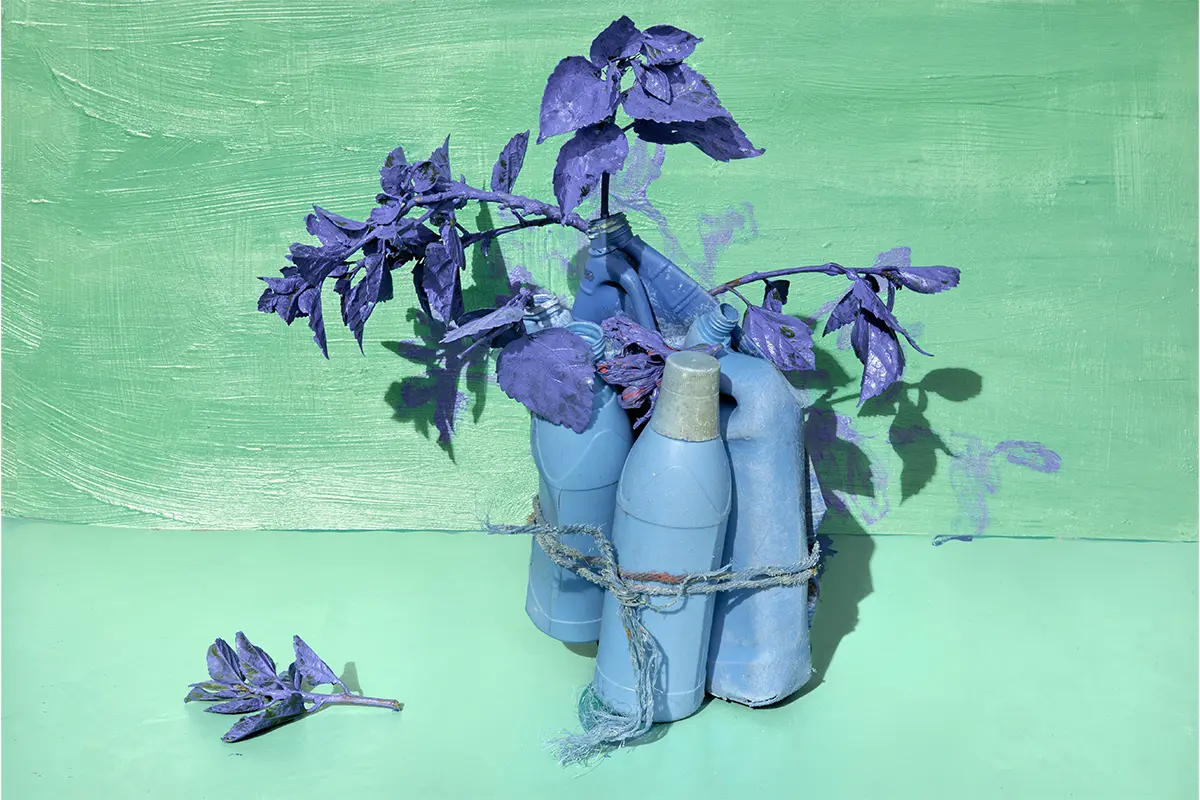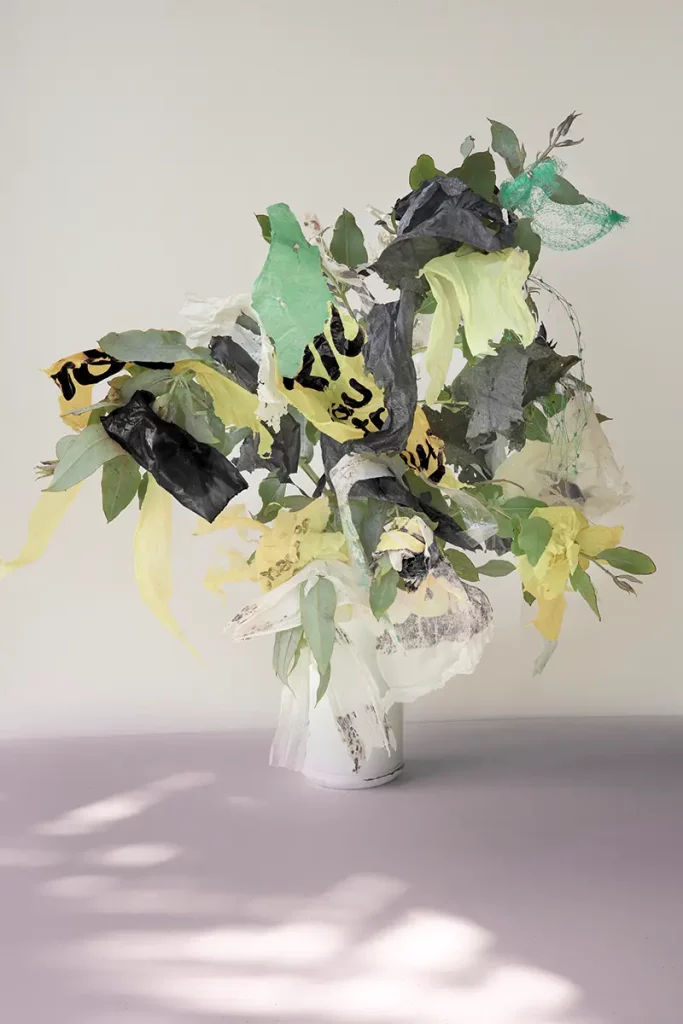Hidden behind the surface – In her photographs, Dutch artist Thirza Schaap uses plastic waste as a material to create sculptures that mix daintiness and disgust
The project Plastic Ocean by Dutch sculptor, photographer, and painter Thirza Schaap explores humanity’s relationship with plastic, its ubiquity in our everyday lives, and its consequences through a combination of two different mediums: sculpture and photography.
In some of her works, Schaap juxtaposes plastic waste with candy-colored backgrounds and natural elements such as flowers and branches, like in her photographs titled Splash of Pink And Mrs. Simpson, where the ugliness of decaying water bottles contrasts the prettiness of hibiscus flowers and a plain pastel background. Other photographs feature plastic waste arranged into sculptures, like in the photos Sparkling, Smiley, and Red Carpet Moment.
Royal Academy’s Climate Summer Exhibition 2022
In 2022, Schaap was among the ten international women photographers presented at Wembley Park’s Outdoor Gallery in London, and her artwork Splash of pink was part of the Royal Academy’s Climate Summer Exhibition 2022.
In 2023, a selection of her works will be featured in Vancouver, British Columbia, at the Capture Photography Festival. Later in the year, the Bildhalle gallery in Amsterdam, the Netherlands, will host a solo exhibit of Schaap’s works.
Finding and using color
After working with black and white film photography for a decade, the Royal Academy of Art of The Hague alumna has become known for her colorful works. Colors and their combinations are elements of the Dutch artist’s work and sources of inspiration.
«I started collecting all the bottles from my working space to the beach. When I had collected hundreds of them, I did a whole project out of them. I grouped them and filled them half full with water so that they would float. I had little groups of them floating in the water: it looked like a water lily field, and I photographed that».
The analogy of the color scheme with Monet
The work that came out was the Waterlilies photograph, where groups of plastic bottles float upside-down with their clear, yellow, green, and purple bottoms glistening in the water. The picture was inspired by the homonymous series of oil paintings by the French Impressionist painter Claude Monet (1840–1926). Like its muse, this photograph is characterized by an analogous color scheme, like those typical of natural waterscapes.
«Like colors, modern paintings are a source of inspiration for the Dutch artist. It can be a shape that inspires me, textures, color combinations, and old paintings. For example, when I see the colors in a Van Gogh painting, the way he uses blue and green in combination with the whites, those are color combinations I get inspired by». Explained the artist.
Collecting and selecting: creating sculptures out of debris
Schaap has a background as a photographer, but her fascination with sculpture and everyday materials has accompanied her since childhood.
«When I was a young child, I liked making little sculptures of things I found around the house. Like the fabrics my mom kept in a basket to make our clothes with or the objects I found in the garage, like little bamboo sticks. I could use everything. That is funny when you are working as an artist, to do something you loved already when you were a child». Schaap recounted.
Selecting plastic debris that has washed up ashore
The materials Schaap utilizes for the artworks from the Plastic Ocean project are not purchased but collected, as the artist selects plastic debris that has washed up ashore. For many of her works, these plastic pieces are assembled into sculptures in her atelier and photographed. Given her medium choice, picking up and preparing bits of debris to work with can be lengthy.
«The creation comprises collecting, selecting, cleaning, trial and error. Then, something comes out at one point: it’s a whole process. Of the things I’m picking up, not all are particularly good. If you go to the more desolate beaches where no tourists go, and when the city is not cleaning the beaches, you can find old plastic pieces that have been exposed to the sunlight in the water. Those are more interesting pieces for me to work with because they tell me something. The trash people left on the beach the night before I call ‘yesterday’s trash’. I can work with that, but it’s not, particularly what I collect. That’s more what I put in a recycling bin. It’s tricky to say how long the whole process takes. The point when I’m creating can go fast, but the whole preparation takes quite some time».
Daintiness and horror – the ugliness hiding behind the pastels
Schaap’s works have many elements of the seventeenth and eighteenth-century botanical still-life paintings of her Dutch countrypeople, such as the painters Margareta Haverman (1693 –1739), Rachel Ruysch (1664 – 1750), and Jan van Huysum (1682 – 1749).
The rise in popularity of still-life subjects in the Netherlands at the time coincided with and was influenced by the urbanization happening in the country and the increasing importance placed on personal possessions.
Many of these paintings of arranged displays of objects, both natural and human-made, contained references to the transience of human life and the material world, like in Willem van Aelst’s “Vanitas Flower Still Life,” where the liveliness of the flowers is juxtaposed with a watch, a symbol of the passing of time. Like those artists, Schaap reflects on a contemporary phenomenon through beauty and symbolism in her works.
Impression – beauty and symbolism that reflect a contemporary phenomenon
Rather than shock the viewer with the reality of plastic pollution, to leave an impression that lasts and sensibilize them, the artist has chosen to lure them in through the daintiness and pleasantness of her works, which then gives way to disgust.
«When you can use art to reach people and almost enter the minds through another door with beauty, aesthetic, colors, and with the feeling that my images invoke in people and then sinks in and plant a little seed that will hopefully then grow inside the person who’s looking at it». The artist disclosed. «Making this combination and using beauty and ugliness together could work and plant a little activism seed in everybody».
A simple message – using beauty as a means for a message
The artist grew up around the water, developing a fondness for the sea as she was brought up in the middle of Holland near the water, and visited the south of France with her parents every summer.
Living close to the sea, the artist had the chance to see the impact of ocean plastic pollution up close in everyday life on the beaches she frequented and felt compelled to share her finds, first with her friends and then on social media. What intrigued her and later pushed her to create artworks out of the debris she saw was the duality of the reaction that trash provoked in her. She found the plastic waste unpleasant and captivating at the same time.
Reaching people and sending a message of urgency
«I was astonished by the amount of plastic we found on the beach. I’d be walking the dog and seeing all the plastic washed up on shore, and I had the urge to share that. I shared that at the beginning with my friends. Then I turned to Instagram because I figured that’s a good platform to show images. There was a duality in the objects I saw: I found them disgusting, but I also found them pretty».
«That duality is what I’m working with. I try to reach people and almost attract them through beauty and aesthetic compositions, and appealing colors. But then, on a second look, people realize what they’re looking at. In that way, I try to reach people and send a message of urgency about the state the world is in and how polluted the beaches are». Thirza Schaap explained.
«It is such a clear subject that I chose that I can use all kinds of executions to translate the same story still. That gives me a lot of freedom and a lot of liberties. I can make a moving image, put your camera on a tripod, and film.
The next day, I can pick up a brush and paint. It’s fantastic when as an artist, you have a message you want so badly to bring out to the world, and then you can use all your creativity or your tools to express yourself. I’m lucky that I have so much inspiration. Sometimes it’s not a lack of inspiration; it’s more a lack of time».
Thirza Schaap
Born in 1971 in the Netherlands and studied at the Royal Academy of Art in The Hague. Since graduation, she has been working as a photographer and is now exploring new art forms in her project “Plastic Ocean.”




















